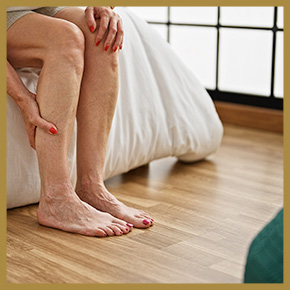Chronic Venous Insufficiency (CVI) is a condition where the veins in the legs fail to efficiently return blood to the heart, often due to damaged valves. This leads to blood pooling in the lower limbs, causing symptoms like swelling, pain, varicose veins, and skin changes. Left untreated, CVI can result in more serious complications like skin ulcers or infections.

Enlarged, twisted veins that result from weakened valves in the veins, leading to blood pooling and visible bulging veins in the legs.
Fluid buildup in the legs due to poor venous circulation, often accompanied by a feeling of heaviness, discomfort, and skin tightness.
RLS is associated with Chronic Venous Insufficiency (CVI) and is characterized by an uncontrollable urge to move the legs, often accompanied by discomfort, especially at night, due to poor circulation and pooling of blood in the lower limbs.
DVT occurs when a blood clot forms in a deep vein, usually in the legs. This condition can cause leg pain, swelling, and redness. It's particularly dangerous because if the clot breaks loose, it can travel to the lungs and heart.
Chronic venous disease is one of the most common vein conditions in Arcadia. As it advances, it leads to an increase in varicose veins, spider veins, and painful symptoms that can become more severe. If left untreated, the condition may result in serious complications such as skin breakdown, chronic non-healing ulcers, or the formation of blood clots. Early diagnosis and intervention are crucial to manage and reduce these risks.
Spider veins are a common example of vein conditions in Arcadia that appear as small, red, or blue veins that commonly appear on the legs, ankles, face, chest, or abdomen, often resembling a fine web or tree branches. Although common, they are frequently linked to larger, deeper veins known as reticular veins, which tend to be blue or green. These dilated vessels can cause discomfort, especially after extended periods of standing. Medically known as telangiectasias, spider veins can indicate underlying venous insufficiency.
Varicose or spider veins that develop around the ankle or legt are known as Corona Phlebectasia. The term “corona” refers to the fan-like pattern these veins create, much like rays radiating from the sun, describing the spread of spider vein capillaries on the inside of the ankle. “Phlebectasia” refers to the presence of abnormal veins and capillaries, together characterizing the distinct fan-shaped pattern of abnormal capillaries associated with this condition.